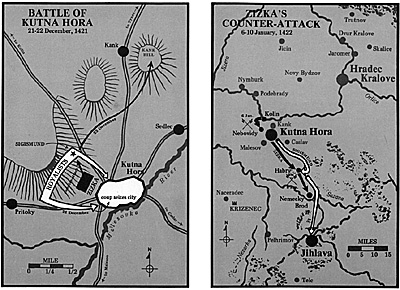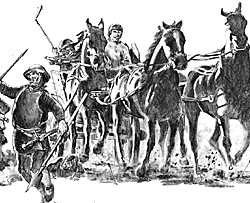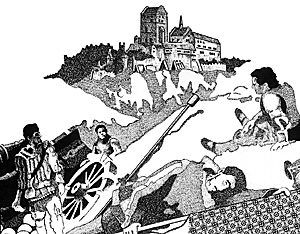On 6 January, 1422, Zizka's augmented force struck the largest encampment of Royalists near Nebovidy, between Kutna Hora and Kolin. Suffering hideous losses, the survivors scattered. When word of this new defeat reached Sigismund he realized that his widely dispersed units would not be able to offer effective resistance. He therefore ordered a retreat to the border and Kutna Hora burned. Hussite pursuit was so rapid that they overran the city before the Hungarians had time to raze it.

In two days, Sigismund travelled twenty miles toward Nemecky Brod and with the help of Scolari managed to bring some order to his shaken army. Overconfident of his army's regrouping, Sigismund decided to make a stand on a hill near Habry on 8 January, despite the vigorously proffered advice of Scolari that the Hungarian morale was too feeble to put up much resistance. Zizka's first charge cracked the Hungarian line and morale, throwing the whole Royalist army into a rout. The Royalist supply and artillery trains were abandoned while Sigismund and his retinue fell back to Nemecky Brod and slipped across the Sazava River barely in time.
The rest of the Royalist army was not so fortunate. Congested at the river, they were slashed at by Zizka's avenging men. Some Royalist cavalry tried to flee across the river, but they broke through the ice and 600 men drowned. On 9 January Sigismund arrived in Jihlava, while bands of Hungarians combined with anti-Hussite Moravians and Poles to try to defend Nemecky Brod. Hussite siege guns reduced the town's fortifications to rubble. The defenders attempted to surrender on 10 January, but Hussite fury was out of control; they broke into the city, routed the defenders, then sacked and razed the buildings. It remained a ghost town for months.
 Counter-attack at Kutna Hora.
Counter-attack at Kutna Hora.
By medieval standards Sigismund's losses had been awesome. The Royalists lost several hundred dead at Nebovidy, 4,000 dead at Habry, and 2,000 dead at Nemecky Brod, in addition to the 600 men drowned in the Sazava. Further, 500 full supply wagons, dozens of guns, and other heavy equipment were lost to the Hussites. Sigismund had not suffered so disasterous a defeat since the Turks trounced him at Nicopolis in 1396.
Sigismund's sorry return to Hungary in March signalled the conclusion of the unsuccessful Second Crusade. It also marked the end of any attempt at another two-front war against Bohemia. Personally, it dissuaded Sigismund from taking any actions against the Hussites for several years. Only a man of Zizka's tactical genius could first escape from encirclement, conduct a totally unexpected attack in the dead of winter, and follow through with a lightning, hammering pursuit most uncharacteristic of medieval warfare.
Sigismund's second loss to Zizka led to further difficulties within the Empire. Under orders from Grand Duke Witold of Lithuania, who desired the Bohemian throne, a small army of 5,000 (including 2,500 cavalry) led by Polish Prince Korybut began striking at the Royalists in Moravia in April, capturing the town of Unicov, and sending emissaries to the Bohemians.
In Bohemia, rejoicing over Zizka's great victory was subdued. Internal religious and political upheavals had rocked Prague as antagonistic factions of Praguers competed for control. In March, 1422, the disputes boiled over when the leader of the capital, John Zelivsky, was beheaded by his opponents. Zelivsky's supporters revolted and quickly reassumed the leadership by a coup. A bloody purge followed, decimating all political groups.
During April, Zizka was forced to move to protect Krasikov from the renewed menace of the Pilseners. Almost surrounded at first, he broke free to capture Zlutice, Gutstein castle near Tepla, and Horsuv Tyn near the German border. By the end of the month he was sufficiently in control to return to Tabor to hear from Korybut's emissaries. Through those conversations a strong friendship developed between the two men, and Korybut had the wedge he needed to assert himself in Bohemian politics; within a matter of weeks Korybut had arranged to have himself elected regent in Prague. Thereafter he set about uniting the Hussites; peacefully by calling a Diet in June, 1422, and violently when the Orebite community resisted his ambitions.
 Karlstein-repository of the crown jewels and the strongest castle in Bohemia. It
never fell to siege.
Karlstein-repository of the crown jewels and the strongest castle in Bohemia. It
never fell to siege.
Attempting to solidify his hold on the reins of leadership, Korybut led the Praguers in July in a siege of Karlstein castle, an isolated Royalist bastion near Prague and the strongest fortress in the country. Despite considerable forces and four of the largest siege guns available, the Praguers failed. The siege dragged on with no victory in sight.
Third Crusade
Meanwhile, in the Empire preparations were underway for still another crusade, the Third. Frederick, Elector of Brandenberg, was given the unenviable task of leading the crusading armies. He assembled his main forces near the Franconian border town of Tirschenreuth, and ordered a 4,000-man Meissen force to assemble north of Erzgebirge on 29 September to prepare for the invasion.
On 7 October, Margrave William and the Meissens crossed the border and seized Chomutov, while Frederick crossed the border and moved on Tachov. Korybut withdrew a major portion of his forces from the siege of Karlstein to deal with the Royalist threat. The peril was not nearly as great as it appeared; the crusaders were poorly organized, of insufficient strength, and lacked the morale to conduct a zealous crusade. Without even encountering the Hussites, the German army began to crumble.
Inexplicably, the reduced Hussite forces besieging Karlstein attempted to overrun the formidable fortress in four separate assaults on 22 October. Not only were the attacks repulsed, but the defenders sortied out to inflict additional heavy casualties. By 8 November the besiegers were forced to sign an armistice with the castle garrison in order to free forces to counter the crusaders to the north. Throughout the remainder of the year the bulk of Korybut's forces parried with the crusaders without a major battle or notable results. By the end of December the crusaders lost all hope of victory and left Bohemia.
With the Third Crusade a fiasco, Sigismund sought to undermine Polish influence in Bohemia, represented by Korybut, by inciting the Prussian Order of Teutonic Knights against Poland in July, 1422. To his great surprise the Prussians were decisively defeated and from that date forward the Poles became mortal enemies of the German King. As a last resort Sigismund turned to the Pope to bring pressure against the Poles to force the Hussites back into the Church. In March, 1423, pressure was strong enough to force the Poles into a nominal alliance with Sigismund to destroy the Hussites. The crusading plan called for a grand invasion on 24 July by the Poles to the north; the Hungarians to the east; the Austrians to the south; and Silesia, Meissen and Saxony to the north end northwest. However, Sigismund's grand scheme never reached fruition.
In the fall of 1422 Zizka again became involved in the dissension between the cities of Prague and Tabor. On St. Michael's Day, 29 September, 1422, a group of Taborites in Prague, which included Bohuslav of Svamberg, attempted a coup. It failed, likely because Zizka had no part in it. He had consistently favored reconciliation between the two cities, but found his relations with both increasingly strained. This was particularly true of his role in Tabor; he was acknowledged as the supreme military commander, but many ignored his opinions on the running of the government. Finding the situation intolerable, in late 1422 he left Tabor forever.
More Hussite Wars
-
Hussite Wars: Introduction
Hussite Wars: Jan Zizka: The Man
Hussite Wars: Papal Schism and John Huss
Hussite Wars: The Land
Hussite Wars: Operations to February 1421 Armistice
Hussite Wars: Operations 1421
Hussite Wars: Operations 1422
Hussite Wars: Operations 1423
Hussite Wars: Operations 1424 and After
Hussite Wars: Hussite Wagon Fort Tactics
Hussite Wars: Medieval Weapons
Hussite Wars: Soldiers
Hussite Wars: Jan Zizka: The Military Leader
Hussite Wars: Large Map of Bohemia/Moravia (slow: 175K)
Hussite Wars: Jumbo Map of Bohemia/Moravia (extremely slow: 504K)
Hussite Wars: Time Line
Back to Conflict Historical Study 1 Table of Contents
Back to Conflict List of Issues
Back to MagWeb Master Magazine List
© Copyright 1976 by Dana Lombardy
This article appears in MagWeb (Magazine Web) on the Internet World Wide Web.
Other military history articles and gaming articles are available at http://www.magweb.com